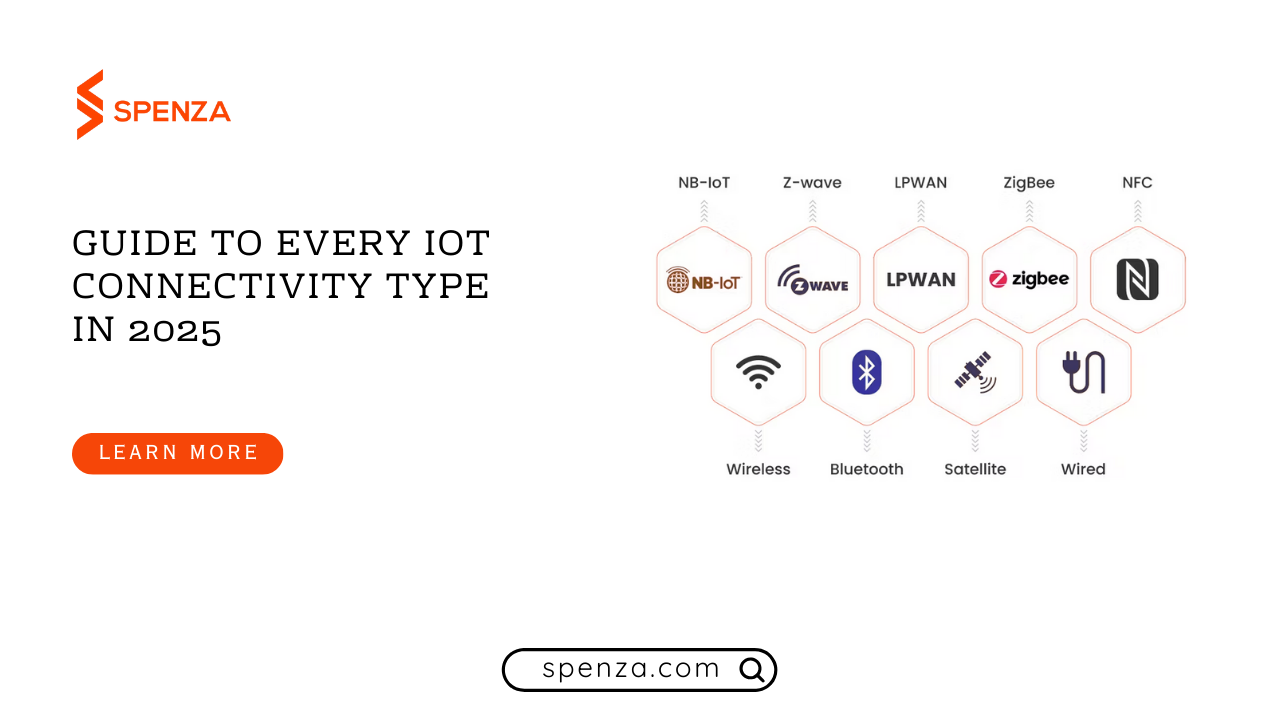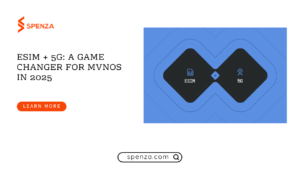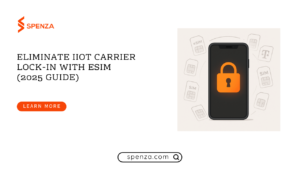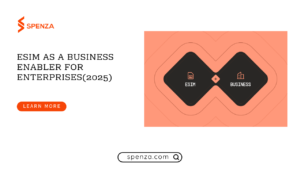Table of Contents
- Introduction
- Choosing the Right Connectivity
- Cellular IoT & LPWAN (Licensed Spectrum)
- NB-IoT (Narrowband IoT)
- LTE-M (Long-Term Evolution for Machines)
- 4G / 5G IoT
- Non-Cellular LPWAN (Unlicensed Spectrum)
- LoRaWAN
- Sigfox
- Beyond Terrestrial Networks
- Satellite IoT
- Short-Range & Local Area Networks
- Wi-Fi / Wi-Fi HaLow
- Bluetooth / BLE
- Zigbee / Thread
- RFID / NFC
- Wired Connectivity
- Ethernet
- Power Line Communication (PLC)
- Comparison of IoT Connectivity Types
- Making Sense of It All
- The Role of a Unified Connectivity Partner
- Spenza: Powering Every IoT Connectivity Strategy in 2025
- One Platform for All IoT Connectivity Options
- Global eSIM Management for IoT
- Enterprise-Grade Security and Scale
- Simplified Contracts and Integration
- Conclusion
- FAQs
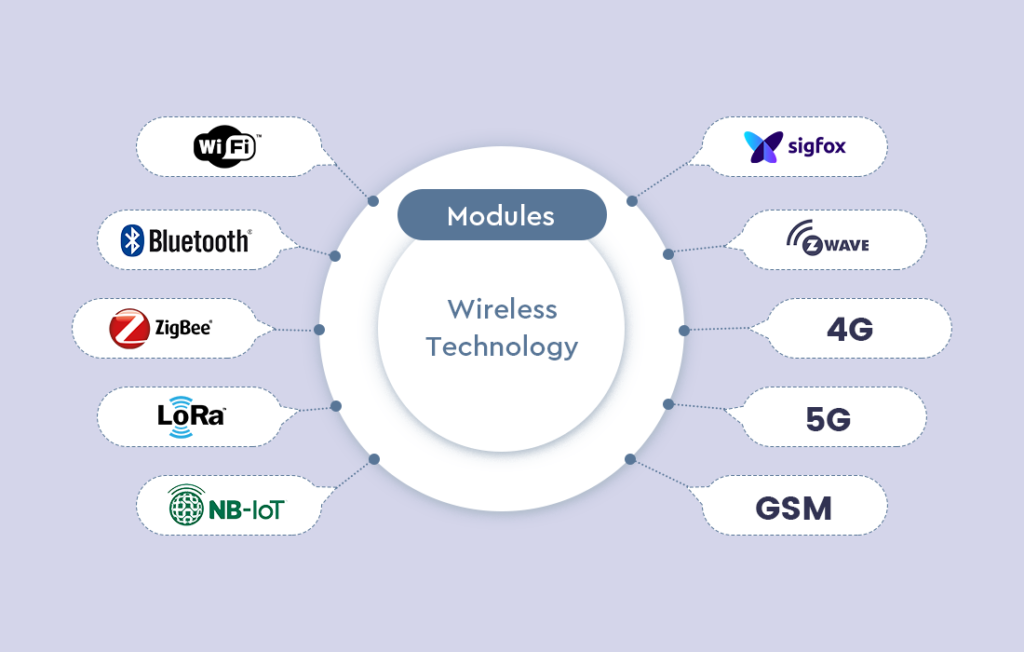
Introduction: The Single Most Important Decision in Your IoT Project
The very first decision that defines an IoT project is not the choice of sensors or the cloud platform. It is connectivity. That one decision influences every other factor: how long devices last in the field, how much money you spend each month, and whether you can expand to global scale or remain stuck in one region.
In 2025, enterprises face a maze of IoT connectivity types. Each has strengths, each has limits. Some are designed for low-power sensors buried in underground basements, while others enable ultra-fast industrial robots powered by 5G. The challenge is knowing which option fits your product without wasting years and millions of dollars.
This guide explains every major IoT connectivity option in detail. It breaks down power usage, coverage, data throughput, and cost. The goal is clarity. If you want a deeper comparison of options, our detailed IoT connectivity strategies guide expands on this framework.
A Quick Framework: How to Choose Your Connectivity
Before we analyze the details, here is a simple framework. Use these four factors to evaluate every connectivity option:

- Bandwidth: How much data do you need to move? Just a few bytes per day, or a video stream in real time?
- Range: Does your network cover a warehouse, a city, or the entire planet?
- Power Consumption: Will the device run for years on a coin battery, or is it plugged into power?
- Cost: What does the hardware module cost upfront, and what do you pay per device each month?
Keeping these four factors in mind will simplify every decision. We also explain how these elements tie into budgeting in our IoT connectivity cost guide.
Cellular IoT & LPWAN (Licensed Spectrum)
Cellular networks remain the backbone of enterprise IoT. According to GSMA, there will be 25 billion cellular IoT connections in 2025. These span three primary technologies: NB-IoT, LTE-M, and 5G. Each solves a different challenge, from smart meters to autonomous cars. We covered why cellular IoT is the most future-proof choice in our 2025 connectivity trends analysis.

NB-IoT (Narrowband IoT)
Before describing its specifications, it is important to understand its purpose. NB-IoT exists to support devices that send very small amounts of data only occasionally. Think of a gas meter that wakes up once a day to send a reading. For this type of application, traditional cellular is wasteful. NB-IoT fills the gap.
What it is
NB-IoT is a narrowband cellular standard that runs in licensed spectrum but with very low bandwidth. It prioritizes coverage and energy savings over speed.
Best For
Stationary devices that rarely transmit but need to last for many years on battery.
Pros and Cons
- Extremely low power usage, with batteries lasting up to 10 years.
- Strong penetration indoors, even in basements.
- Data rates limited to a few kbps.
- No support for mobility, which means it cannot handle moving trackers.
Use Cases
Smart meters, agricultural sensors, smart building monitoring.
Cost
Modules are cheap, typically $3–$5. Data plans often start at $0.20–$0.50 per month.
Our NB-IoT vs LTE-M comparison breaks down technical trade-offs for decision-makers comparing NB-IoT with LTE-M.
LTE-M (Long-Term Evolution for Machines)
Some devices need more than tiny packets. A health wearable, for instance, may need to transmit continuous monitoring data while also supporting mobility. This is where LTE-M enters.
What it is
LTE-M is a cellular LPWAN standard designed for devices that move and need higher throughput than NB-IoT. It also supports voice transmission.
Best For
Mobile devices that need moderate speed and good battery life.
Pros and Cons
- Data rates up to 1 Mbps, which is significantly higher than NB-IoT.
- Works with cell handovers, so devices can move between towers without losing connection.
- Power use is higher than NB-IoT but still efficient.
Use Cases
Asset trackers, fleet telematics, medical devices, and personal wearables.
Cost
Modules usually cost $5–$7. Plans range from $0.50–$1.50 per device/month.
4G / 5G IoT
When devices need speed, 4G and 5G remain unmatched. 5G is the most advanced, delivering ultra-low latency and gigabit speeds. But with power and cost trade-offs.
What it is
These are the mainstream cellular networks adapted for IoT. 4G LTE still supports a massive share of devices, while 5G drives growth in high-performance IoT.
Best For
Applications that require real-time response or data-heavy transfers.
Pros and Cons
- 5G latency as low as 10 ms.
- High throughput, often more than 1 Gbps.
- Modules are expensive at $15–$30.
- Battery drain is significant.
Use Cases
Autonomous vehicles, industrial robots, video surveillance, and smart manufacturing.
Cost
Data plans for 5G IoT devices are higher, typically $2–$5 per month depending on data usage.
We recently explained why single-carrier 5G strategies are risky in our analysis on IoT carrier risks.
Non-Cellular LPWAN (Unlicensed Spectrum)
Not every IoT solution needs cellular. For many cities, campuses, or farms, private LPWAN networks in unlicensed spectrum work well.
LoRaWAN
LoRaWAN stands for Long-Range Wide-Area Network. It is widely used by enterprises that want to build their own IoT coverage.
What it is
LoRaWAN operates on unlicensed spectrum with long range and low power. It is not owned by operators, which makes it flexible for private deployment.
Best For
Organizations wanting control of their own coverage with thousands of low-power devices.
Pros and Cons
- Range up to 10 km in rural areas and 3 km in cities.
- Battery life often up to 10 years.
- Low data rates, from 0.3 kbps to 50 kbps.
- Spectrum can be noisy in dense cities.
Use Cases
Smart city lighting, parking systems, agriculture, and industrial monitoring.
Cost
Modules cost $3–$6. Deploying gateways costs $1,000–$5,000 each.
Our LoRaWAN use cases overview discusses where enterprises successfully adopt LoRaWAN in 2025.
Sigfox
Sigfox is a unique LPWAN operator with its own global infrastructure. It sends extremely small messages with very low power.
What it is
A proprietary network using ultra-narrowband to send a few bytes at a time.
Best For
Simple, stationary devices that need to send short alerts.
Pros and Cons
- Ultra-low power and simple to use.
- Global availability in some regions.
- Only a few messages per day allowed.
- Coverage varies and may not exist everywhere.
Use Cases
Smoke alarms, small asset tags, and alert systems.
Cost
Devices cost $2–$4, with plans at $0.20–$0.50 per month.
Beyond Terrestrial Networks
When nothing else works, satellite IoT fills the gap. This is key in maritime, mining, or desert applications.
Satellite IoT
What it is
Connectivity provided by satellites in Low Earth Orbit (LEO) or Geostationary Orbit (GEO).
Best For
Remote and global deployments where terrestrial networks cannot reach.
Pros and Cons
- Global coverage without limits.
- LEO satellites provide lower latency (30–50 ms). GEO satellites can be as high as 600 ms.
- Modules are costly at $50–$100.
- Plans average $1–$5 per device/month.
Use Cases
Global shipping, remote agriculture, mining, oil and gas, and pipelines.
For businesses looking to combine cellular IoT with satellite IoT, our eSIM provider analysis explains how multi-network support is managed in 2025.
Short-Range & Local Area Networks
For consumer and enterprise IoT in local environments, short-range standards are still strong.
Wi-Fi / Wi-Fi HaLow
Wi-Fi continues to dominate homes and enterprises. In 2025, Wi-Fi 6 and 7 support IoT with higher speeds and better efficiency. HaLow supports longer range at lower power.
What it is
Wireless networking that connects devices at short range, with new standards optimized for IoT.
Best For
Smart homes, offices, and high-bandwidth devices.
Pros and Cons
- Very high throughput, up to gigabit levels.
- Easy to deploy with existing routers.
- Consumes more battery than LPWAN.
Cost
Modules cost $2–$5, with no monthly fees beyond broadband.
Our IoT connectivity plan guide explains when Wi-Fi remains the most cost-effective option compared to cellular.
Bluetooth / BLE
Bluetooth Low Energy dominates wearables and small IoT gadgets.
What it is
A short-range standard optimized for very low power.
Best For
Wearables, health devices, beacons, and short-range sensors.
Pros and Cons
- Very low power usage.
- Simple and cheap modules.
- Range limited to 10–30 meters.
Cost
Modules cost $1–$3.
Zigbee / Thread
These mesh protocols allow many devices to connect in one local network.
What it is
Short-range mesh standards for smart home and building automation.
Best For
Lighting, HVAC, and home automation.
Pros and Cons
- Mesh networking extends coverage.
- Good for thousands of nodes in one building.
- Management complexity increases with scale.
Cost
Modules cost $2–$4.
RFID / NFC
These remain the backbone of logistics and identification.
What it is
Short-range wireless identification, often passive.
Best For
Asset tagging, retail, payments, and ID systems.
Pros and Cons
- Extremely cheap, sometimes $0.10 per tag.
- Requires physical proximity to readers.
Wired (Ethernet, PLC)
Some industries still need wired connections for 100% reliability.
What it is
Traditional wired standards such as Ethernet and powerline communication.
Best For
Industrial systems where uptime and speed matter more than mobility.
Comparison of IoT Connectivity Types
| Technology | Range | Data Rate | Power Use | Module Cost | Data Cost (USD) | Best Use Case |
|---|---|---|---|---|---|---|
| NB-IoT | City-wide | ~250 kbps | Very low | $3–$5 | $0.20–$0.50/mo | Smart meters, sensors |
| LTE-M | Nationwide | ~1 Mbps | Low | $5–$7 | $0.50–$1.50/mo | Trackers, wearables |
| 5G | Nationwide/global | >1 Gbps | High | $15–$30 | $2–$5/mo | Cars, robotics, video |
| LoRaWAN | 3–10 km | <50 kbps | Very low | $3–$6 | Private setup | Agriculture, smart cities |
| Sigfox | Regional/global | Few bytes/msg | Ultra low | $2–$4 | $0.20–$0.50/mo | Smoke detectors, alerts |
| Satellite IoT | Global | 1–100 kbps | Medium | $50–$100 | $1–$5/mo | Shipping, pipelines |
| Wi-Fi 6/7 | 30–50m indoors | 100 Mbps–1 Gbps | High | $2–$5 | Free w/ broadband | Smart homes, video devices |
| Bluetooth BLE | 10–30m | <2 Mbps | Very low | $1–$3 | Free | Wearables, beacons |
| Zigbee/Thread | Mesh (100m hops) | <250 kbps | Low | $2–$4 | Free | Smart lighting, automation |
| RFID/NFC | <10 cm–5m | <1 kbps | Ultra low | $0.10+ | Free | Payments, ID, logistics |
| Ethernet/PLC | Fixed line | High (100 Mbps+) | N/A | Varies | Free | Industrial, stationary IoT |
Making Sense of It All: The Role of a Unified Connectivity Partner
By now it is clear that no single technology can solve every IoT challenge. A company may use Bluetooth for onboarding, Wi-Fi for firmware updates, and cellular IoT for global tracking. This fragmentation makes IoT connectivity types harder to manage.
That is why choosing a unified partner matters. Without one, businesses spend too much time juggling contracts, integrations, and carrier limitations.
Our recent connectivity strategies guide explains that enterprises in 2025 rarely rely on one network. They combine LPWAN technologies such as LoRaWAN with cellular IoT and even satellite IoT for remote sites. The complexity multiplies fast.
Spenza: Powering Every IoT Connectivity Strategy in 2025

1. One Platform for All IoT Connectivity Options
Spenza is designed as a modern MVNE for both MVNOs and IoT-focused deployments. That means you manage cellular IoT, LPWAN technologies, and satellite IoT in one platform.
Instead of separate dashboards and carriers, you use one simple API-first system. That single layer brings order to fragmented IoT connectivity options.
2. Global eSIM Management for IoT
With IoT devices shipping worldwide, global coverage is no longer optional. Spenza supports integrated SIM and eSIM provisioning across 190+ countries. Whether you deploy NB-IoT vs LTE-M in North America or 5G in Europe, you activate devices instantly. This avoids the common trap of single-carrier lock-in, as shown in our single-carrier IoT risks guide.
3. Enterprise-Grade Security and Scale
IoT growth in 2025 is not just about adding more devices. It is about protecting data and scaling without losing control. Spenza enables policy controls, compliance support, and visibility across every connection. That means enterprises can adopt LoRaWAN use cases for agriculture while still maintaining strict data security.
4. Simplified Contracts and Integration
Instead of multiple regional contracts, Spenza gives you one global agreement. That matters when scaling across markets with mixed IoT connectivity types. Integration is simple, thanks to an API-first design that connects directly into enterprise IoT platforms. Our IoT eSIM provider analysis explains why this approach saves time and cost in real deployments.
Conclusion: There Is No Best, Only Best for You
There is no single winner across IoT connectivity types. The right choice depends on bandwidth, power, range, and cost. Some projects succeed with NB-IoT, others need LTE-M, while others require satellite IoT to operate at all. The important step is knowing how to choose IoT connectivity wisely, not chasing trends.
Enterprises need a flexible partner to manage this complexity. Spenza makes it possible to adopt the right IoT connectivity options without worrying about integration, scale, or cost traps. Whether you explore LoRaWAN use cases, NB-IoT vs LTE-M trade-offs, or global satellite IoT deployments, Spenza provides one place to manage it all.
FAQs
Evaluate bandwidth, range, power, and cost. The correct choice depends on whether devices are stationary, mobile, or globally deployed.
NB-IoT suits static sensors needing ultra-low power. LTE-M supports mobility, higher throughput, and moderate energy. Choose based on use case.
LoRaWAN use cases expand because enterprises want private, flexible, and low-cost IoT networks, especially for agriculture and smart city deployments.
Satellite IoT is used in shipping, mining, pipelines, and remote agriculture, where no terrestrial network coverage exists or is reliable.
Cellular IoT averages $0.50–$2 monthly per device. LPWAN is cheaper, satellite IoT higher, while Wi-Fi and Bluetooth are free.
Spenza unifies cellular, satellite, and LPWAN technologies with eSIM management, global contracts, and enterprise-grade security across over 190 countries.
Ready to simplify your IoT connectivity strategy? Talk to Spenza today and discover how a single platform powers every IoT connectivity option you need.
